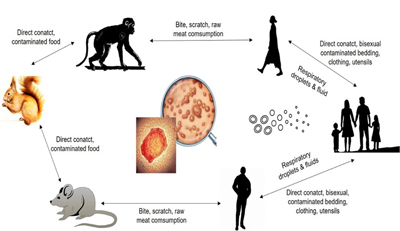Monkeypox virus: A comprehensive review of taxonomy, evolution, epidemiology, diagnosis, prevention, and control regiments so far
Authors: Rokshana Parvin, Ahmed Ali , Abdou Nagy, Zheng Zhu, Suhui Zhao, Jüregn Neuhaus, Alok K. Paul, Hafez M. Hafez and Awad A. Shehata
Ger. J. Microbiol.
2022.
vol. 2, Iss. 2
pp:1-15
Doi: https://doi.org/10.51585/gjm.2022.2.0014

Abstract:
Poxviruses as a group have variable levels of host ranges and virulence. For example, smallpox, which is caused by the variola virus, only infects humans with fatal outcomes, whereas related viruses, such as cowpox viruses can infect multiple hosts, but only cause mild disease in humans. Recently, the monkeypox virus (MPXV) re-emerged and infected over 780 human cases in over 20 countries worldwide at the time of writing this review. It has been shown before not only monkeys play a role in the transmission of MPXV to humans, but also rodents (Cricetomys gambianus, and Graphiurus murinus) and squirrels (Heliosciurus spp, Funisciurus spp). In addition, anthropogenic actions, such as deforestation, climatic changes, animal-human interfacing, globalization, and the cessation of smallpox vaccination, could contribute to the re-emergence of MPXV. Herein, we review the current nomenclature, epidemiology, genetic diversity of poxviruses, particularly MPXV, and the control regiments, including available antivirals and vaccines. We further highlight the genetic relatedness of the emergent MPXV viruses to know viral lineage using phylogenetic analysis.
Keywords:
Poxviruses, Monkeypox, Transmission, Anthropogenic action, Re-emergence
Statistics:
Article Views: 6764
PDF Download: 179